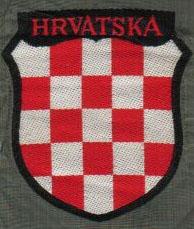|
Croatian Oficial Shield The oficial Croatian national shield was authorized to be worn on uniform in July 1941. The shield is a machine woven checkered shield consisting of 25 squares and the inscrption "HRVATSKA" in red on a black field at the top. | |
|
Verstarken Kroatischen Infanterie Regiment 369 The independent
state of Croatia was formed on 10 April 1941, ten days after the Axis invasion of
Yugoslavia. Croatia being the chief beneficiary annexed Bosnia and Herzegovina,
which is a Muslim state. Its founder was Ante Pavelic, political leader of the
Ustasha party, which had nationalistic, catholic and anti-Serb policies. During
the Russian campaign, Croatians volunteered to fight alongside Germany. A Croatian
Legion composed of three infantry battalions was formed, two raised at Varazdin, and
the other one formed of Bosnian Croats from Sarajevo, Bosnia-Herzegovina. | |
|
Croatian Legion Awards About a thousand men were evacuated from Stalingrad via air and were used to form the core of a new Croatian volunteer units of the Wehrmacht. These veterans were awarded a commemorative badge shown below, the "Croatian Legion 1941" Linden Leaf in silver. | |
|
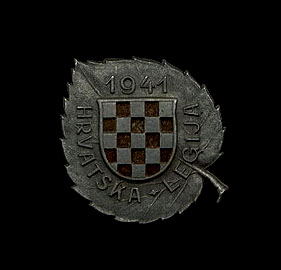
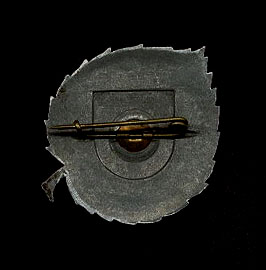
Not much information is available on this Croatian decoration. The only thing known so far is that former veterans of the Croatian 369th Infantry Regiment who survived the battle of Stalingrad were awarded with the Army Legion Badge for the Eastern Front. The badge shown above was awarded probably in early February 1943. The Legion badge was manufactured in the form of a linden leaf with the national coat of arms shown in the center and in bold relief the words "HRVATSKA LEGIJA" (Croat Legion) with the date "1941." The reverse shows a safety style pin attached in the center by a small bronze plate. I have seen it with a German style hinge, needle pin and "C" catch going across the badge horizontally. These badges were made by the firms: "BRACA KNAUS-Zagreb" and "Me-Ba" Zagreb. These badges were made of aluminum and in silver color only. Veterans wore this badge on the left breast pocket of their German or Croatian uniform and on the side of their M-43 style German Cap. | |
|
The Croatian Airforce Legion The "Kroaten-Staffeln" Croatian Air Force was formed on 2 June 1941. It was composed of a fighter squadron and a bomber squadron. The squadrons were equipped respectively with Me109bf's and the Do17's. They were attached to the German fighter groups JG52 and JG53. The fighter group was commanded by Oberst Franjo Dzal. The Air Force saw action from 6 October 1941 to July 1944 over many sectors; the bombers raiding Moscow at one point while the fighters saw action in the Caucasus. In July 1944 the Croatian airmen returned to their own country to help stop the partisan threat. | |
|
The Croatian Airforce Legion Badge 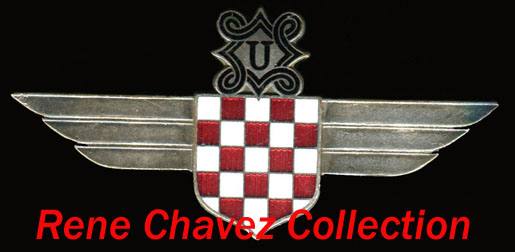
Not much is known about the " Znak Hrvatske Zrakoplovne
Legije" (Croatian Airforce Legion badge), except that is was worn by Croatian members of
the Legion and German pilots attached to the legion. The badge is made of solid stroke silver
metal with the Croatian national shield soldered in the center of the wings. Surmounted
above the enameled checkerboard shield is the "Ustase" emblem. The reverse shows a
long thick pin held by a hinge and a "C" style catch. The badge was made by the Croatian firms
Braca Kaus and Me-Ba of Zagreb, and by the German firm Juncker. | |
|
Croatian Legion in Italian Service In addition, to the Croatian regiment which fought at Stalingrad, there was a smaller Croatian unit integrated into the Italian 8th army, which fought on the river Don front-line. The legion was composed of two small battalions of more of less 500 Croatian volunteers. It was referred as the Light Mobile Regiment "Laki Prijevozni Zdrug" and was formed on July 26, 1941, which came about after a meeting between Italian General Antonio Oxilio and Poglavnik Ante Pavelic. Italo-Croat Legion Shield 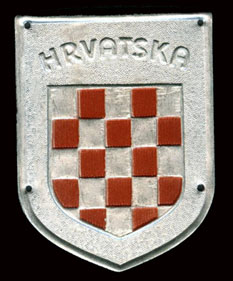
Members of the Croatian Light Transport Regiment Legion wore an aluminum metal shield with the bold relief inscription "HRVATSKA" and the painted red checkerboards representing the coat-of-arms. The metal shield has four corner holes were it was sewn on the right or left upper arms. Italo-Croat Legion Badge 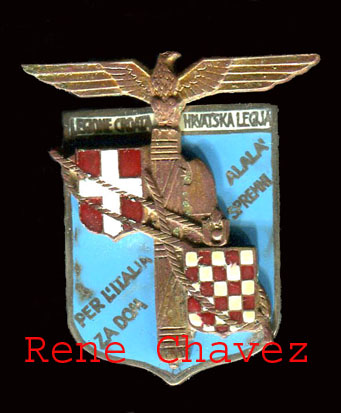
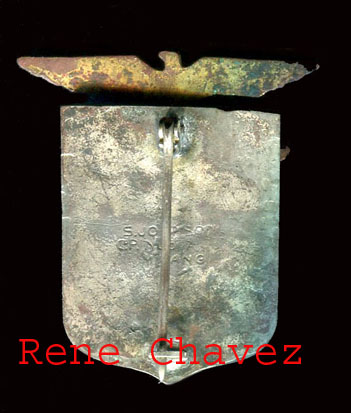
In addition, officers were also presented with a breast badge as the one shown above and were worn on the left pocket of the uniform. It was an enameled metal badge and consisted of a shield with the Italian blue Savoy background. The shield is divided vertically into two by a surmounted bronze color Fasces with an eagle on top and is tied to a rope. In the upper left corner the Italian coat of arms of Savoy and, diagonally to the bottom right, the Croatian coat of arms. Diagonally, on two lines, the two golden mottos of the Legion: the Italian, "PER L ITALIA,ALALA" and the Croat "ZA DOM SPREMNI." Above the shield, in gold letters on a white background, the words "LEGIONE CROATA" and "HRVATSKA LEGIJA." |
